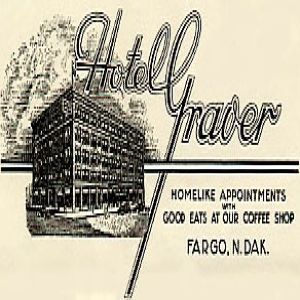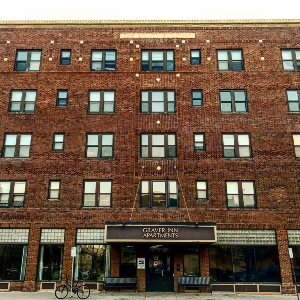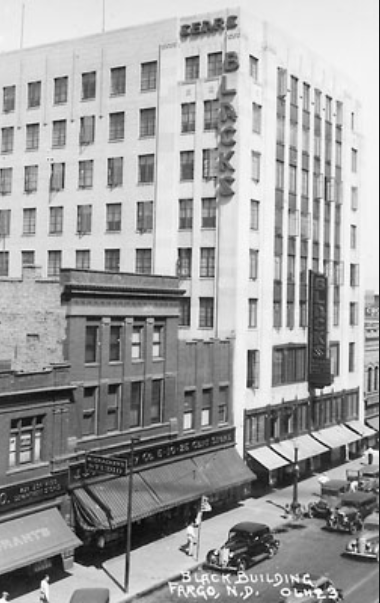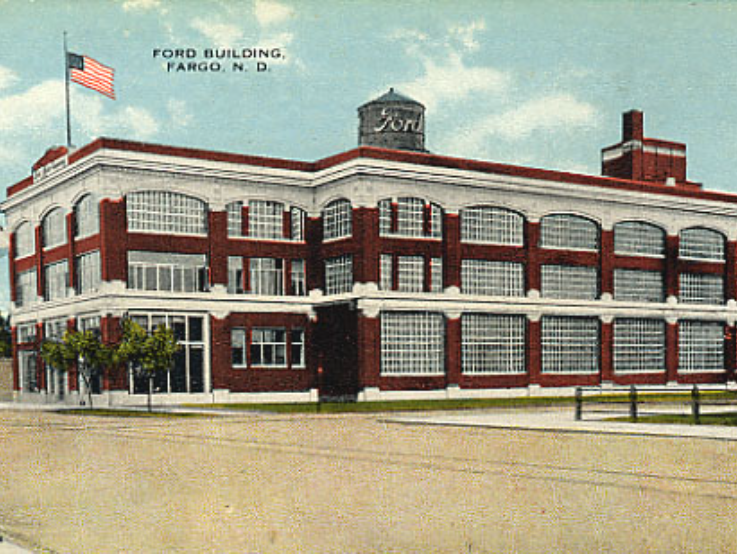Downtown Fargo History
A few fun history tidbits on the buildings of Downtown Fargo!

Moody’s Department Store
Way back in 1881, Alfred L. Moody and C. D. Whitehouse opened their own dry goods store on Broadway and 3 years later, Moody purchased Whitehouse’s share. Soon after the purchase, Moody moved to a busier area of downtown, on the corner of Broadway and Front Street or what we know today as Main Street. Soon, Moody was able to take over all three floors of the building including the basement and sold items such as suits, cloaks, and shoes. One advertisement states: “If you wish something really good, go to Moody’s”.

Moody retired in 1940 and sold his life’s work to Julius Sgutt. Moody died on Christmas Eve 3 years later, but Sgutt along with his brother carried on Moody’s legacy. After a name change to Sgutt-Moody’s Inc. and two moves (65 Broadway then 608 Main Avenue) Sgutt’s widow, Sybol, took over after he passed and altered the business to sell fine ladies fashion. Sybol operated the store until 1992 when she retired.
Fun Fact: Moody’s was located at 522 Main Street (where the Wells Fargo building is located today) for over 80 years.
Golden Maid Cafe
The Golden Maid Cafe was run by two brothers who immigrated to Fargo from Pakia, Greece in 1915. Located at 68 Broadway, this little cafe opened around 1925 and served lunch, candies, and soda. Every once in a while, you could even catch some live music. Unfortunately like many businesses, the Golden Maid Cafe was destroyed by a fire in 1941 and the cafe never reopened.


Fun Fact: 68 Broadway is the storefront between Juice It and Tea & Crepe.
Anyone else think It would be cool to have a retro little cafe come back to #DowntownFargo?
Silver Tray Cafe
Abraham Solow opened the Silver Tray Cafe at its first location, 14th 8th St. around 1933. Fast forward 2 years to 1935 and the Silver Tray moved to 604 Front Street which is the current home to Babb’s Coffee House! The Silver Tray moved a third time to NP between 1939 and 1940. The final move happened in 1947 to 408 Broadway along with a name change to the Silver Tray Tavern around 1954. Louis Hoffman purchased the cafe from Solow and closed in 1976.

Fun Fact: The Silver Tray Cafe was one of the first Fargo establishments to apply and receive a liquor license in 1936!
deLendrecie’s Building
Before it there was a deLendrecie’s building, Mr. Onesine Joassin DeLendrecie started a general store called, the Chicago Dry Goods House. After growing out of their space a few years later, the deLendrecie’s building broke ground in 1894 but it’s a little different than the deLendrecie’s building that we know today as the top 3 floors were added on later. You could find dresses, coats, gloves and even stop in at the coffee shop for lunch!
In 1972, the department store moved out to West Acres Mall and was in business there until they were purchased by Dillard’s 1998 and the space turned into Herberger’s.


Today, the top 3 floors are apartments and the bottom 2 floors are office space.
Fun Fact: When the building was sold to to the New York company, Mercantile Stores Co. the building was rebranded as Block 6. Truthfully, we like “The deLendrecie’s Building” much better than Block 6 🙂
Graver Hotel
The Graver Hotel was built in 1917, at the same location as the old Fargo Opera House which burned down in December 1912. Like many great stories, the Graver Hotel begins with a couple in love. The owner of the hotel, Vern Parker, was madly in love with Grace Jennings and made a grand romantic gesture by combining the first 3 letters of each of their names and thus, the Graver Hotel got its name. Sadly, Vern passed away only a year after the hotel’s opening, and he and Grace never married.



In 1976, North Dakota State University purchased the building to use as student housing until the mid 1980’s.
Today, the Graver Hotel is located at 123 Roberts Street and is currently the home to apartments, Vinyl Giant, Game Giant, Graver Barbers, Amped School of Music, and Gruber Guitars.
Fargo Forum
Our hometown newspaper, The Forum, dates back to 1873 when it originated as the Fargo Express to serve the budding settlement along the Northern Pacific Railway. Its current headquarters at the corner of 5th Street and 1st Avenue North was built in 1926. The design of the building is Art Deco composed of steel and concrete and was built at a reported cost of $300,000. The third and fourth floors were not added until 1935.

The Forum building is one of the many iconic Downtown Fargo buildings that create our unique skyline, as it’s easy to spot the LED-lit FORUM sign towering from the roof. The award-winning newspaper is available in print or online at INFORUM.com.
Fun Fact: In an 1899 issue of The Forum, Holmes Clothiers advertised silk and linen suits for men at $4!
The Plains Art Museum
Established in 1965 as the Red River Art Center in Moorhead, MN, the Plains Art Museum was given its current name in 1975. In 1996, the Museum moved across the river into North Dakota and embarked on renovating a former International Harvester warehouse into the beautiful space of art and culture we know today. The Plains Art Museum is an increasingly important community anchor in Downtown Fargo. The Museum offers free admission to its 56,000 square feet filled with diverse mediums of art. As the largest accredited art museum in the State of North Dakota, it is a place for curious minds from all over the world. The Plains Art Museum connects art, artists, and audiences to foster creative, resilient, and welcoming communities. Learn more at PlainsArt.org

Fun Fact: Hammel Green & Abrahamson, Inc., redesigned the International Harvester Warehouse – you can find their award-winning work at the Minneapolis Institute of Arts.
Black Building
George M. Black was an early merchant in Fargo, opening The Black Store on Broadway in 1912. In 1929, after witnessing the stock market collapse, he bet big on Fargo and sold his store to Sears, Roebuck and Company. He used the proceeds to finance the construction of the Black Building, the eight-story office tower that stands today at 114 Broadway. The Black Building was completed in 1931 with Sears leasing 40,000 square feet and the rest became premier office space with all the modern amenities of its time. It was North Dakota’s tallest building until 5 years later when the capitol building in Bismarck was built at 21 stories. The building’s namesake sign you see today was installed in 2019. It was inspired by the original sign that was installed in the 1930s and removed in the 1970s. Learn more at www.TheBlackBuilding.com.



Fun Fact: As you can see, The Black Building is in fact, not black but white. This oxymoron made it into Ripley’s “Believe it or Not” newspaper!
Sons of Norway Lodge
Currently, home to Starion Bank and the Moose Dixon Apartments, the old Sons of Norway Lodge is located at 305 and 309 Broadway. Built-in 1911, the lodge encompassed the second and third stories. On the second floor, you would find the stage, kitchen, banquet room, club rooms, and a library. The third level consisted entirely of the balcony auditorium which overlooked the stage. The lodge was a space for many speakers who came to share their knowledge and held gatherings rooted in Nordic traditions.


The Sons of Norway has a new home at 722 2nd N Ave just South of NDSU’s business school. The Kringen Lodge 25 Sons of Norway “strives to promote and preserve Norwegian culture and heritage through our food, activities, education, and events.” You can join them for lunch Monday-Friday from 11:00 am -1:30 pm! We recommend the strawberry rhubarb pie 😋
Ford Building
Just like the name suggests, the Ford Building was built in 1915 as a Ford automobile plant and showroom to service the Dakotas. Built in a Chicago style along the Great Northern Railroad tracks, this building boasted the perfect location to assemble cars, load them onto railroad cars, and send them on their journey. Ford moved its operations to Minneapolis in 1956 and the building became an appliance store, then a printing shop, and finally, retail and office space on the first and second floors and condominiums on the third.


Fun Fact: “Ford Day” is July 23rd! This event was created to celebrate the completion of the building in 1915!
